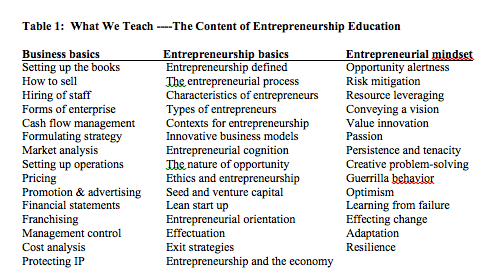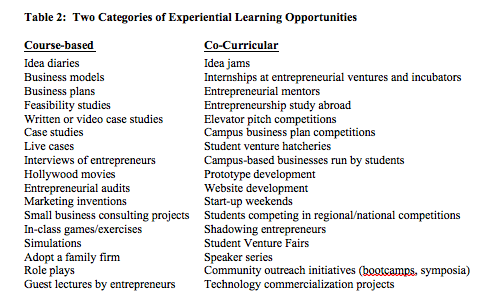Building Blocks of Successful Entrepreneurship Programs

These key building blocks can guide the ongoing development of entrepreneurship programs, improving their quality and substance.
Over the past 25 years, university academic programs devoted to entrepreneurship have grown remarkably despite a variety of obstacles and challenges. (Kuratko 2005). The number of colleges and universities offering courses related to entrepreneurship has grown from a handful in the 1970s to thousands across the globe today. Large numbers of universities now offer majors, minors, concentrations, certificates and graduate degrees in entrepreneurship. Some of the more prestigious research universities have developed Ph.D. programs to prepare the next generation of scholars in the field. Entrepreneurship centers and institutes can be found at close to 1,000 universities and colleges, and a growing number of institutions are launching academic departments, co-departments, and schools (Morris, Kuratko, and Cornwall 2013).
As the growth continues, more attention must be devoted to the quality and substance of these programs rather than merely increasing their numbers. Here are suggested key building blocks to guide the ongoing development of entrepreneurship programs.
Building Block #1: Defining the Purpose
The first step in developing a high impact entrepreneurship program is to determine its purpose. This will help to define the relative emphasis on different stakeholders, and how much the program is focused on the business school, the campus or the community. Consider some possibilities. At a basic level, the program may simply seek to inform students (in business schools or across a campus) about the nature of entrepreneurship. A more ambitious purpose might aim to encourage development of an entrepreneurial mindset among students and other stakeholders (e.g., faculty, staff, administrators, alumni). Yet another purpose can be to foster actual startups, again by different stakeholder groups. Alternatively, the advancement of theory and scholarly insights regarding entrepreneurship can serve as the driver of the program. Some programs seek to impact the institution itself, helping to create what has been called "the entrepreneurial university."
Hand in hand with establishing a purpose is the question of how one actually conceptualizes the entrepreneurship program. Here are some examples of how those working within the program might define themselves and approach what they do.
- The program as an administrative unit
- The program as an academic unit
- The program as a venture
- The program as an innovation factory
- The program as a platform for empowerment and transformation
Is one simply trying to efficiently and effectively manage programs, or does the program serve as a catalyst for innovation and change? Ironically, the challenge is to determine how entrepreneurial the entrepreneurship program seeks to be.
Building Block #2: What We Teach
The core entrepreneurship curriculum at an institution provides a common knowledge base for students. For many programs, the core curriculum not only serves undergraduate and graduate students pursuing formal entrepreneurship degree programs, but also those from across campus interested in getting some exposure to the discipline. Its design is a reflection of how the faculty conceptualizes entrepreneurship, the relative importance they place on the discipline, and their priorities in terms of critical topical areas.
If we consider the content of modern entrepreneurship programs, it would seem the learning elements fall into three categories: a) business basics as they relate to new venture creation and management; b) core entrepreneurial content; and c) the entrepreneurial mindset. Table 1 provides examples of what is or might be taught in each of these three areas.

My concern is that business basics tend to dominate the content of many entrepreneurship programs, particularly when they are taught by individuals without much exposure to the academic discipline of entrepreneurship. Yet, it could be argued that much of what is listed under business basics could be taught by existing units within a business school, and eliminates the need for an entrepreneurship faculty. Much more attention is needed in developing and delivering core entrepreneurship content, and, most importantly, content that relates to the entrepreneurial mindset and associated competencies.
Building Block #3: How We Teach
Entrepreneurship content is delivered through conventional lectures, flipped classrooms, online platforms, and various other vehicles. But the key to how the content is taught in the coming years lies in how educators make the learning process experiential. Entrepreneurship educators are leading the way in experiential learning, or how students learn by doing and by observing what others do. Targets must be set for the percentage of total learning that occurs experientially. Two corollary issues concern how much experiential learning is built into entrepreneurship courses, and how much is designed to occur outside the classroom, through so-called co-curricular programming. Table 2 provides examples of experiential learning initiatives built into entrepreneurship courses and ones associated with co-curricular learning.

For their part, students are increasingly expected to build experience portfolios as they progress through their studies in entrepreneurship. Hence, upon completion of a minor, major, certificate, or other program in entrepreneurship, the student might submit a portfolio summary that includes their work on idea diaries, elevator pitches, business models, small business consulting reports, interviews with entrepreneurs, entrepreneurial audits, study abroad experiences, and so forth.
Building Block #4: Where It Lives
The structure used to manage an entrepreneurship program dictates how it will be led, to whom it will report, how it is staffed, and how it operates from a budgetary standpoint. The program is more credible if it's part of an academic unit, rather than one that is administrative in nature. Another factor affecting the program's credibility is whether its leaders can control degree programs and courses. The leader also matters: Is he or she a terminally qualified, tenure track faculty member in the leadership position, a clinical faculty member, or an administrative staff member?
Structural decisions also determine reporting relationships and who must approve new programs and initiatives. Another critical decision concerns whether to make the entrepreneurship program part of the business school or put it somewhere else. A final element is how much those involved with the program can control their own budgets. The structure of the program will affect its freedom to pursue sponsorships, endowments, operating gifts and grants; how received monies are expended; and the extent to which monies remain within the program.
Some of the more common structural forms include: entrepreneurship as an area of study (usually as a sub-area within some established academic unit), entrepreneurship centers and institutes, co-departments (e.g., a department of management & entrepreneurship); departments of entrepreneurship; and schools of entrepreneurship. Although most are affiliated with colleges of business, each structure presents its own governance and resource issues. For instance, an entrepreneurship center housed in a business school may have limited access to resources to support various cross-campus entrepreneurship efforts. The program must also develop an explicit funding model based on the structure selected. Selecting from among these structures is a principle means of ensuring a structural base from which entrepreneurship can operate and become sustainable. Additional oversight from a board of advisors consisting of administrators, faculty and outside stakeholders can further foster sustainability.
Building Block #5: How We Assess Outcomes
How do we know if entrepreneurship programs actually accomplish anything? Despite the increasing amount of resources going to support these programs, the evidence is not conclusive and few can agree on appropriate performance metrics.
From a teaching standpoint, the conventional academic unit is evaluated on a mix of criteria, ranging from numbers and characteristics of students enrolled in courses to ratings from teaching evaluations and successful job placements for graduates. Entrepreneurship programs rely on similar metrics, but they also receive pressure -- particularly from donors, alumni, and some of the entrepreneurship program ranking services -- to focus on venture creation metrics. It gets us back to the purpose of such programs. Focusing on how many students actually launch ventures, and how many of these ventures are still around in five years, implies entrepreneurship programs exist primarily to foster start-ups. Even here, though, it may be more useful to track venture-related activities undertaken by students. Entrepreneurship is temporal, and opportunities and ventures come and go. Hence, the program should track such variables as business models developed, business plans written, prototypes developed, patents or IP protection applied for, customer surveys completed, seed money proposals made, and related activity-based metrics. This also reinforces the experiential nature of entrepreneurship education.
Yet, if programs are attempting to prepare students for a life of entrepreneurship, and seeking to instill an entrepreneurial mindset, the coming years will find more emphasis on mastering competencies -- to address the question, “What should students get better at because they studied entrepreneurship?” Those competencies might include recognizing opportunities and leveraging resources, for example. Our research (Morris, Webb, Fu, and Singhal, 2013) has uncovered 13 key entrepreneurial competencies that should be the focus of entrepreneurship education. These include many of the items listed in column three of Table 1.
Beyond such competencies, as more priority is placed on cross-campus entrepreneurship, basic metrics might be extended to include the number of students involved with elements of the university-wide effort within each college or discipline; inter-disciplinary collaborations that result in publications; new courses and course modules developed and implemented; measures of student and faculty innovations that are traceable to involvement in the program; and economic and social impacts of collaborative community engagement projects.
And finally…
As entrepreneurship education continues to advance, the real danger is “institutionalization.” With widespread acceptance and greater legitimacy within higher education, entrepreneurship programs will inevitably face pressure to conform and become bureaucratic like other units on campus. Those leading these programs must resist this pressure. The possibilities of entrepreneurship on a university campus are immense, but realizing these possibilities requires academic entrepreneurs who are not afraid to take risks and affect change. The conundrum moving forward will involve determining how to maintain an entrepreneurial edge while surviving in what can sometimes seem to be an anti-entrepreneurial environment.
References
Kuratko, D. F. (2005). The emergence of entrepreneurship education: Development, trends, and challenges. Entrepreneurship theory and practice,29(5), 577-598.
Morris, M. H., Kuratko, D. F., & Cornwall, J. R. (2013). Entrepreneurship programs and the modern university. Edward Elgar Publishing.
Morris, M. H., Webb, J. W., Fu, J., & Singhal, S. (2013). A Competency‐Based Perspective on Entrepreneurship Education: Conceptual and Empirical Insights. Journal of Small Business Management, 51(3), 352-369.
More ideas
College business professors looking for more ideas to enrich the classroom experience can find them here.
Additional Search Terms: entrepreneurship courses, teaching ideas, teaching resources, classroom ideas, entrepreneurship classes, business schools, business school classes, entrepreneurship students, professors



